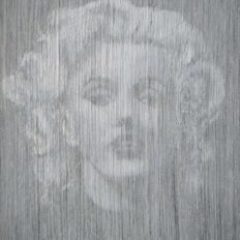Strip Paintings
Introduction
The “Strip Paintings” need an explanation. The term is my own and refers to the process of creating the work.
The Theory
The process came about with reference to the multiple screen prints of Andy Warhol. In direct contradiction to the mechanical reproduction of his iconic images, I painted three identical oil paintings of the same image, cut these into fine strips and reassembled them, in profile, to form a unique image. The finished work, despite the same starting point as Warhol’s, is diametrically opposed to his. The thickness of the paint, the thickness of each hand cut strip and the alignment of the hundreds of strips, when reassembled, make each painting unique. This involves many hours of work and elements of craft and skill absent in Warhol’s “multiples”. The earlier work is mounted in self-made frames of thick plywood that place them in the context of the utility furniture of the Pop Art period. The ironic twist is that this whole process involves its own reference to Warhol’s “multiples” in that each finished piece is made of three identical paintings.
Further Development
Subsequent work has explored the scale, the image, the framing and the process itself. Is there a limit to the scale of the work e.g. “Elvis”? . What happens when the technique is applied to other iconic images e.g. “Flag”? . What happens when the image and the process combine e.g.”Barcode series”? Does framing with modern materials, like aluminium, change the nature of the work e.g.”Flag”? Can other formats work e.g.”Red Wheel”?
